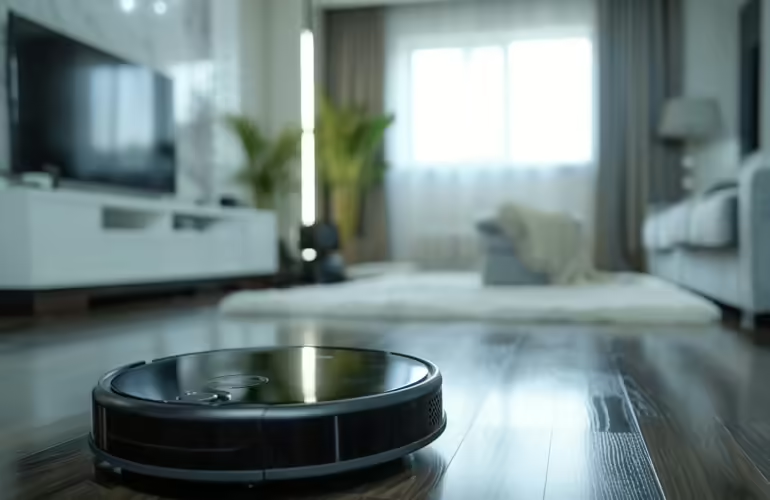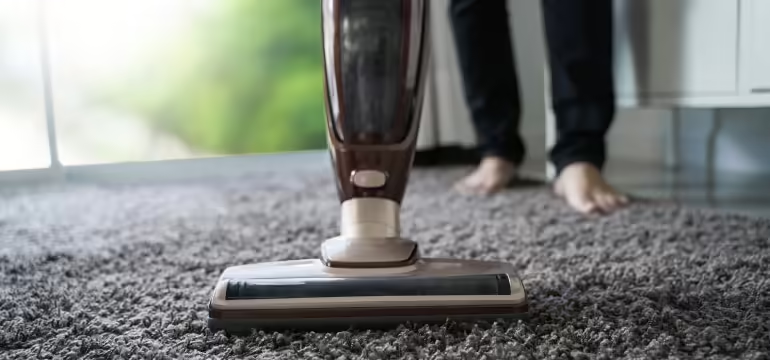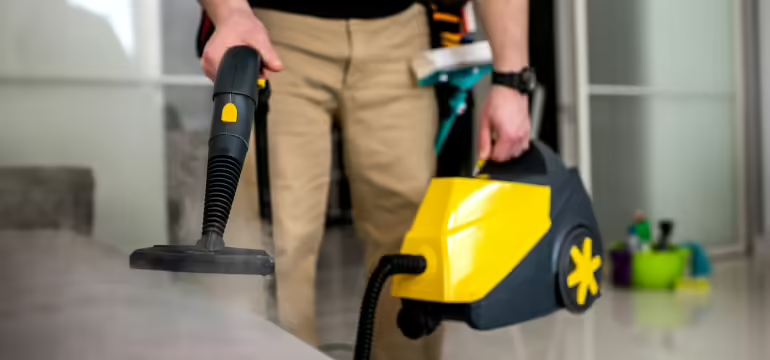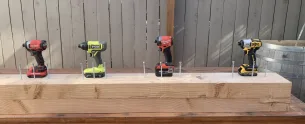Advertising Disclosure
How to Choose a Vacuum Cleaner for Your Home
There are many different vacuum cleaners in the market. Choosing a suitable model is a challenging process. The main thing is to know how a vacuum cleaner works. You must also determine the types. So you will choose the best option for your home. We’ve compiled helpful tips and key features of vacuum cleaners. They will help you to manage these cleaning devices. How to choose a vacuum cleaner? You must understand this question tailored to your needs.
Remember about specific cleaning requirements. They are handling pet hair and allergens or cleaning hard-to-reach areas. All influence your decision. You don’t have to be an expert in home appliances. With the help of our recommendations, you will be able to understand the crucial aspects. Then, you will buy a perfect vacuum cleaner. Let’s dive into the details.
Understanding Different Types of Vacuum Cleaners
You must know all the various types available. It will help you to make an informed decision. Each type offers unique advantages and drawbacks. The choice depends on your cleaning needs. Here’s a breakdown of the most common types:
- Upright Vacuums: These models are known for their powerful suction. Upright vacuum cleaners can cover large carpeted areas efficiently. They are easy to maneuver. Such vacuums often contain various attachments for different surfaces. They can be bulky and challenging to use on stairs or under furniture. Are you looking for the best vacuum cleaner for suction? An upright model is often a top choice.
- Canister Vacuums: They are flexible and great for cleaning carpets and hard floors. They typically feature strong suction. Such a vacuum comes with a separate canister. It makes it easier for them to move around and store. They can be cumbersome. The hose and wand can be awkward. It helps to manage in tight spaces. This type is often highlighted in the best vacuum guide for versatile cleaning.
- Robotic Vacuums: These models are ideal for automated, hands-free cleaning. Such vacuums are compact. They can navigate obstacles to clean floors with minimal effort. These models are convenient. They may offer a different level of deep cleaning than upright or canister models. Such vacuums require regular emptying and maintenance. Robotic vacuums are perfect for maintaining cleanliness between more thorough vacuuming sessions.
- Stick Vacuums: They are lightweight and easy to use. It makes them ideal for quick clean-ups. Such models are typically cordless. They offer convenience but often lack larger models’ suction power. Stick vacuums are great for small spaces. They suit a secondary vacuum. Such models are great for quick tasks. Stick ones excel in convenience and ease of use when considering what to look for in a vacuum.
- Handheld Vacuums: These models are compact and portable. They are perfect for cleaning small areas, upholstery, and car interiors. Such vacuums are highly convenient. They need more power and capacity for extensive cleaning tasks. Handheld vacuums are best for spot cleaning or reaching tight spaces.
You should understand these different types. It will help you choose the best vacuum cleaner. It will fit your lifestyle and storage needs.
Upright Vacuum Cleaners: Pros and Cons
Upright models offer several benefits and drawbacks. They are essential to consider. You will choose the best vacuum cleaner for your home. Let’s begin with the benefits:
- Effective on carpets: Upright vacuums excel at deep-cleaning them. They often have motorized brushes. They lift embedded dirt and pet hair.
- Large capacity: These vacuums usually have bigger dirt containers. They reduce the frequency of emptying during cleaning.
- Powerful suction: Most upright models have strong suction. It makes them efficient for carpets and hard floors.
- User-friendly design: Many feature easy-to-use controls and adjustable heights. They allow for comfortable use across various floor types.
- Affordability: Upright vacuums tend to be more budget-friendly. This is in comparison to other types. They are canisters or robot vacuums.
Now, let’s discuss the drawbacks:
- Heavy and bulky: Upright vacuums can be heavy. It makes them difficult to maneuver. This is especially hard on stairs or tight spaces.
- Noisy operation: They can be louder compared to other vacuum types. This is because of their powerful motors.
- Limited flexibility: They are effective on flat surfaces. These vacuums may need help to clean under furniture or in tight corners.
- Storage space: Their upright design often requires more storage than compact vacuums.
Look for models that balance power, maneuverability, and convenience to meet your needs. Do it when consulting a vacuum cleaner buying guide.
Canister Vacuum Cleaners: Ideal for Hard Floors
Canister vacuums are often preferred for homes with hard flooring due to their superior flexibility. Here are the benefits:
- Powerful suction: Canister vacuums are known for their high suction power. It makes them ideal for removing dirt, dust, and debris from wood, tile, and laminate.
- Flexible cleaning: Their design allows for easy movement. It helps users navigate around furniture, under tables, and into tight corners. There, upright vacuums may struggle.
- Gentle on surfaces: Canister vacuums often come with specialized attachments. They are soft bristle brushes. These vacuums clean hard floors. It happens without scratching or damaging them.
- Lightweight and maneuverable: The separate canister unit means less weight on your hand. It makes the vacuum easier to maneuver over large areas without fatigue.
When buying a vacuum cleaner, canister models offer versatility and powerful performance. They also can clean delicate surfaces effectively. They are a top choice for those seeking thorough, gentle cleaning.
Key Features to Consider When Buying a Vacuum Cleaner
Let’s explore the key factors that will help you make the right choice:
- Suction Power: A vacuum’s effectiveness depends heavily on this point. Higher suction power ensures better cleaning on carpets and hard floors. They help to remove embedded dirt, dust, and pet hair.
- Filter Technology: HEPAs are crucial for indoor air quality concerns. They trap 99.97% of dust, pollen, and allergens. It makes them ideal for homes with allergy sufferers or pets.
- Bagged vs. Bagless Models: Bagged vacuums are great for those who prefer a cleaner disposal process. The dust is contained within a sealed bag. Bagless vacuums save on the cost of replacement bags. They require frequent bin emptying and filter cleaning.
- Floor Type Adjustability: Does your home have a mix of carpets, rugs, and hard floors? Select a vacuum with adjustable settings or a motorized brush. It can switch between different floor types for optimal performance.
- Weight and Maneuverability: Consider how easy the vacuum is to move around. This is essential if you need to clean stairs or large spaces.
Have you decided which vacuum cleaner is best? Look for a model that matches your cleaning needs. It must offer the right balance of power, filtration, and convenience.
The Importance of Filter Technology in Vacuum Cleaners
The filtration system is a critical feature. This is important for households concerned about indoor air quality. Advanced filters are crucial in trapping dust, allergens, and fine particles. It makes them particularly beneficial for allergy sufferers. Let’s discuss all the specifics of vacuum cleaner buying:
- HEPA Filters: They capture 99.97% of particles as small as 0.3 microns. These are pollen, pet dander, and dust mites. Such filters significantly reduce allergens in the home.
- Multi-stage Filtration: Some vacuums feature such systems. They combine a pre-filter to capture larger debris and a secondary filter. It helps to trap finer particles. Such a filtration ensures cleaner exhaust air.
- Activated Carbon Filters: They neutralize smells for homes with pets or strong odors. They also filter out harmful particles.
- Washable vs. Replaceable Filters: Different types of vacuum cleaners offer them. Washable ones can be reused. Replaceable ones provide better performance. They require regular replacement for optimal air quality.
Bagged vs. Bagless Vacuum Cleaners: Which to Choose?
Let’s explore how to buy a vacuum cleaner. The choice between bagged and bagless models is a crucial decision. Each has its pros and cons. Let’s begin with bagged vacuum cleaners. Here are the advantages:
- Hygienic disposal: Dust and debris are sealed within the bag. It makes disposal cleaner and reduces the risk of exposure to allergens.
- Better filtration: Bagged vacuums capture fine particles more effectively. It makes them a good vacuum cleaner for allergy sufferers.
- Low maintenance: The bag contains most of the dirt. So, filters don’t need frequent cleaning.
Here are the disadvantages:
- Ongoing costs: You’ll need to purchase replacement bags regularly. It can add to long-term costs.
- Decreased suction as the bag fills: Suction power may decrease as the bag fills up. It requires more frequent bag changes.
Now, we will talk about bagless vacuum cleaners. Here are their benefits:
- Cost-effective: No need to purchase replacement bags. It makes them more budget-friendly over time.
- Transparent bins: You can easily see when the dust cup needs to be emptied.
Here are their disadvantages:
- Dust exposure: Emptying the dust cup can release allergens.
- Filter maintenance: Bagless models require regular cleaning or replacement of filters. It helps to maintain suction power.
Both types can be good home vacuum cleaners. Your decision will depend on budget, allergies, and convenience.
Considering the Size and Layout of Your Home
The size and layout of your home play a significant role. It determines which type of vacuum cleaner will be most effective. Let’s explore how to choose the best cleaning vacuum:
- Multi-level Homes: Consider a lightweight or cordless model. If your home has multiple floors, a lightweight model makes it easier to carry up and down stairs. Stick vacuums are known for their portability, but ensure they offer good suction. Alternatively, some homeowners prefer two vacuums. One for each level to avoid lugging heavy equipment around.
- Large Homes: A vacuum with a long power cord or a cordless model with extended battery life is ideal. A model with a larger dirt container capacity is also recommended to minimize interruptions. Look for the most powerful home vacuum. Ensure thorough cleaning over large areas. This is especially important if you have a mix of carpet and hard flooring.
- Homes with Lots of Furniture: A canister vacuum is a good option. They are more maneuverable and come with attachments. Such vacuums make cleaning under and around furniture easier.
Dyson, Shark, and Miele are several of the best vacuum cleaner brands. They offer versatile options. Such features cater to different home sizes and layouts. Prioritize models with flexible attachments, strong suction, and ease of use.
Maintenance and Durability of Vacuum Cleaners
It’s important to consider maintenance requirements and durability. This helps to ensure a long-lasting and reliable purchase. Different models have varying upkeep needs. Proper maintenance can significantly extend their lifespan. Here are vital aspects:
- Regular Filter Cleaning: These points help to maintain suction power for bagged and bagless models. High-suction vacuum cleaners rely on clear filters to avoid clogs and reduced performance. HEPA filters should be cleaned or replaced according to the instructions. It helps to ensure efficient filtration.
- Emptying the Dust Cup or Replacing Bags: This step avoids overfilling and dust buildup after each use in bagless vacuums. They should have bags replaced once they reach around 70% capacity. It will help to prevent suction loss. This also helps prevent strain on the motor.
- Brush Roll Maintenance: This is prone to tangling with hair and debris. Regularly inspect and clean it to avoid excessive wear and tear. It can cause damage to carpets or reduce cleaning efficiency.
- Check for Blockages: Periodically check the hoses and attachments for blockages. Clogged hoses can overheat the motor, shortening the vacuum’s lifespan.
- Motor Care: Turn off the vacuum when not in use. It will help to prevent the motor from overheating. Some high-end models come with thermal protection. It safeguards against motor burnout.
- Warranties: They are essential when purchasing a vacuum. They protect against defects and costly repairs. Many top brands offer extended warranties, typically 1 to 5 years.
Follow these maintenance tips. Consider the warranty coverage in reviews of vacuum cleaners. So you can ensure your cleaning device lasts many years. It will deliver high performance throughout its life. For more cleaning tips and product recommendations, visit our website. They will make your life better.







